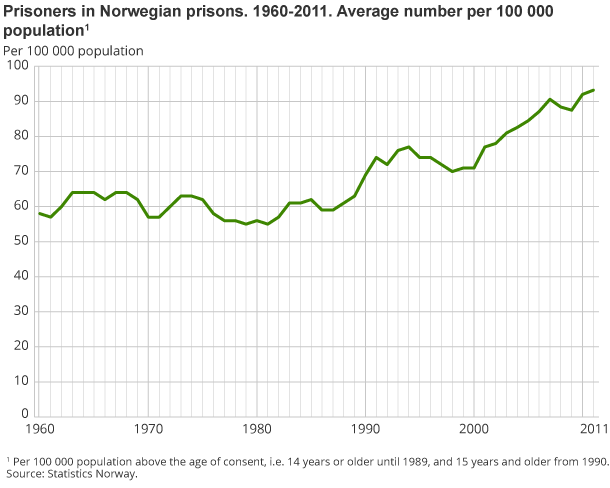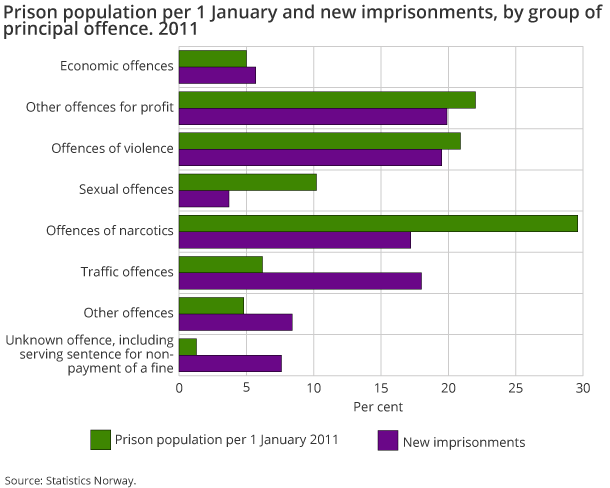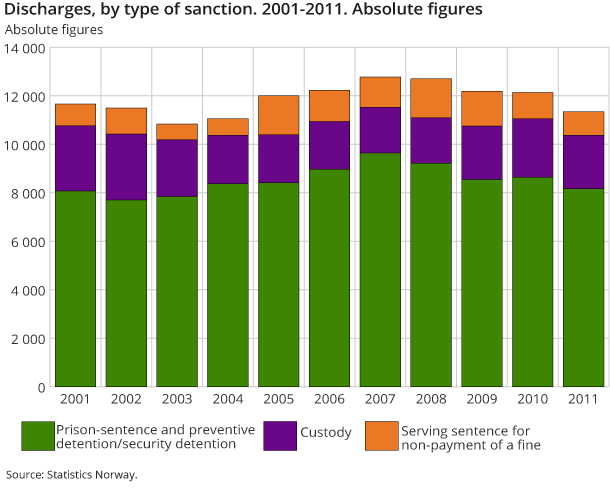Content
Published:
This is an archived release.
More spending long periods in prison
On average, there were 3 727 prisoners per day in Norwegian prisons in 2011, which is 2.8 per cent more than the year before. This is partly due to more use of Halden prison and a higher number of long prison sentences. In addition, more sentences were served using electronic monitoring outside prisons.
| Total | Custody | Prison-sentence in institution | Prison-sentence, electronic monitoring | Preventive detention | Serving sentence for non-payment of a fine | |
|---|---|---|---|---|---|---|
| Prison population by 1. January | 3 866 | 884 | 2 798 | 66 | 70 | 48 |
| Discharges | 11 341 | 2 203 | 7 201 | 960 | 7 | 970 |
In the historical statistics dating back to 1960, the year with the highest average number of persons in Norwegian prisons is 2011, and this is also still the case if we account for the increase in population in these years (see figure). On an average day in 2011, 2 639 persons were serving a prison sentence, 79 were in preventive detention, 74 were serving sentences for non-payment of a fine and 935 persons were in custody.
On average, there were 6 per cent more persons serving a prison sentence and 11 per cent more in preventive detention in 2011 than in the previous year. The average number in custody was 6 per cent lower, but still considerably higher than in all previous years (1960-2009). The numbers of persons serving sentences for non-payment of a fine was 3 per cent lower than in 2010, and the lowest since 2004.
Halden prison contributed to an increase
The opening of Halden prison in 2010 affects the interpretation of the tables in the statistics on prisons for the period 2009-2011. For instance, 302 more prisoners were registered at the beginning of 2011 than in 2010. An increase in capacity in Halden prison was the reason for the increase in 151 cases. According to the Norwegian Correctional Services` annual statistics for 2011, Halden prison had almost 82 000 prison stays, which is 65 per cent more than during 2010.
Many in prison for drug offences
Per 1 January 2011, the prison population in Norwegian prisons was 3 866, including persons serving sentence by electronic monitoring . Of the total prison population at the beginning of the year, 30 per cent had a drug crime, 22 per cent had an offence for profit and 21 per cent had a violent crime as their principal offence.
Of the 884 in custody at the beginning of 2011, the principal offence was a drug offence in 37 per cent of cases. Larceny and other offence for profit was the principle offence for 28 per cent of persons in custody and the corresponding figure for violence was 16 per cent.
Offences by prisoners entering prison in a single year are relatively different to those we see among persons who are in prison at any given time. Of a total of 11 239 new imprisonments in 2011, the principal offence was a traffic offence in 18 per cent of cases, while the share among prisoners at the beginning of the year was 6 per cent. Of the new imprisonments, drug and sexual offences made up 17 per cent and 4 per cent of the principal offences respectively, while the corresponding share for those in prison on 1 January was 30 per cent and 10 per cent respectively (see figure).
The composition of offences varies for the different types of sanctions. For instance, 55 per cent of the new imprisonments served using electronic monitoring had a traffic offence as the principal offence.
Men in the majority and most aged 30 years and older
At the beginning of the year, over 93 per cent of the prisoners were men, and of the prisoners with known age 64 per cent were aged 30 or older. The share of men has remained relatively stable in the last ten years. The share of prisoners aged 30 or older has been relatively stable during the last six years, but it was higher than for the years 2001-2005.
Of all prisoners aged 30 or younger at the beginning of the year, 52 per cent had either offences for profit or violent crimes as a principal offence. The corresponding share among those aged 30 or older was much lower, at 39 per cent. Compared to those aged 30 or younger, those 30 or older had a much larger share of drug offences, economic offences and traffic offences as a principal offence. Of a total of 255 women in prison at the beginning of the year, 40 per cent had drugs as a principal offence, while the corresponding share for men was 29 per cent.
Decrease in new prison sentences
In 2011, 7 246 new imprisonments serving a sentence were registered, and 912 of those were new imprisonments served using electronic monitoring. In addition, 1 540 transfers made directly from custody to serving prison sentences were registered and in total 4 per cent fewer prison sentences began overall.
More serving long prison sentences …
Of a total of 8 161 discharges from prison in 2011, 1 988 prisoners had served a sentence three months or longer, which is almost 9 per cent more than in 2010. In addition, there was a 12 per cent decrease in the number of short prison sentences lasting less than a month and a 6 per cent decrease in sentences lasting between one to three months.
…and more spending long periods in custody
Of a total of 3 717 discharges from custody and transfers made directly from custody to serving prison sentences, 1 489 lasted for 60 days or longer. This is 7 per cent more than in 2010, and as much as 45 per cent more than in 2008.
Fewer discharges from prison
In 2011, there were a total of 11 341 discharges, which is 6.5 per cent fewer than in 2010, and the lowest since 2004. Compared to 2010, there were almost 7 per cent fewer discharges from prison, 9 per cent fewer discharges from custody and 10 per cent fewer discharges from serving sentence for non-payment of a fine. There were almost 5 per cent more discharges from prison sentences served using electronic monitoring (see figure).
Electronic monitoring included in the prison statistics from 2008 Open and readClose
Those who serve either all or part of their sentence using electronic monitoring are included in the statistics on prisoners at the beginning of the year, with entries (including new imprisonments) and departures (including discharges) included as from 2008, when this was introduced as an experimental arrangement. The use of electronic monitoring is now so extensive that this arrangement is crucial to the interpretation of these prison statistics. Those who serve either all or part of their sentence using electronic monitoring are not included in the statistics on the number of days spent in penal institutions in the year or figures on average numbers of prisoners.
Contact
-
Susanne Fjelldalen
E-mail: susanne.fjelldalen@ssb.no
tel.: (+47) 40 90 26 43
-
Kristin Bergvall
E-mail: kristin.bergvall@ssb.no
tel.: (+47) 92 66 55 13
-
Reid Jone Stene
E-mail: reid.jone.stene@ssb.no
tel.: (+47) 99 02 22 01



